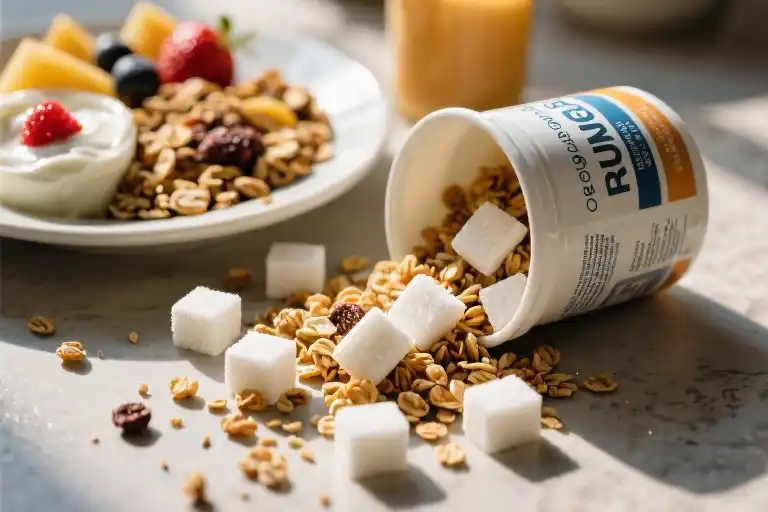The question “How long will it take to lose weight?” carries the same elusive answer as asking “How long is a piece of string?” Yet this uncertainty doesn’t stop millions from searching for definitive timelines, often left frustrated by generic advice that ignores biological individuality.
Weight loss journeys resemble snowflakes – no two are identical. Your neighbor might shed pounds effortlessly while your scale refuses to budge, not because you’re doing something wrong, but because dozens of physiological variables interact uniquely in every body. During my years as a health coach (pre-Ozempic era), I witnessed clients with nearly identical diets and exercise routines experience dramatically different results over six months – some celebrating 30-pound losses while others worked twice as hard for 15-pound drops.
This variability stems from six key personal factors:
- Metabolic fingerprint: Your basal metabolic rate (BMR) operates like a car engine’s idle speed – some bodies naturally burn more calories at rest
- Hormonal landscape: Thyroid function, cortisol levels, and reproductive hormones create invisible speed bumps or accelerators
- Muscle-to-fat ratio: Lean tissue acts as metabolic currency, with each pound burning 6-10 daily calories versus fat’s 2-3 calories
- Life stage realities: A 25-year-old’s cellular repair efficiency differs markedly from someone in perimenopause or andropause
- Movement patterns: An office worker’s NEAT (non-exercise activity thermogenesis) varies wildly from a nurse’s 12-hour shifts
- Medical considerations: Conditions like PCOS or insulin resistance require specialized approaches
Understanding these variables transforms frustration into empowerment. When Sarah, a 42-year-old teacher, panicked about “only” losing 8 pounds in three months while her sister dropped 15, we analyzed her metrics: improved sleep quality (+22%), blood pressure reduction (128/82 → 116/74), and visceral fat decrease (12% → 9%). The scale told an incomplete story.
This introduction leads us to three crucial realizations:
- Comparing weight loss timelines proves as futile as comparing fingerprints
- Non-scale victories often matter more than arbitrary deadlines
- Scientific literacy about your body’s workings reduces anxiety when progress isn’t linear
In the following sections, we’ll decode why two people eating identical meals may see different scale reactions tomorrow, how to distinguish meaningful fat loss from meaningless water fluctuations, and why that stubborn plateau might actually signal your body adapting positively. You’ll meet real clients whose journeys defied generic expectations, and most importantly, learn to craft a personalized roadmap that honors your unique physiology rather than fighting against it.
The Factors That Make Your Weight Loss Timeline Unique
Trying to predict exactly how long your weight loss journey will take is like guessing how many steps it’ll take to walk across an unfamiliar city – your pace, the terrain, and even the weather all play a role. Through years of coaching clients through their transformations, I’ve identified six key factors that create this highly personal timeline.
Your Body’s Engine: Basal Metabolic Rate (BMR)
Think of your BMR as your body’s idle speed – the calories you burn just keeping the lights on. Two people of the same weight can have BMRs differing by 300+ calories daily. That’s equivalent to:
| Factor | Impact on Daily Calorie Needs |
|---|---|
| 10 lbs muscle | +50-100 calories |
| Thyroid issue | ±200 calories |
| Aging (per decade) | -50 calories |
The Time Machine Effect: Age
Metabolism naturally slows about 1-2% per decade after 30. But here’s what most don’t realize – this decline isn’t inevitable. My 52-year-old client Mark actually increased his metabolic rate by 11% through resistance training, proving age is just one piece of the puzzle.
Biological Blueprints: Sex Differences
Women’s weight loss journeys often look different due to:
- Monthly hormonal fluctuations (water retention varies by 3-5 lbs)
- Typically higher body fat percentages
- Different fat distribution patterns
One study in Obesity Journal found men lose weight 16% faster initially when following identical programs.
Your Silent Ally: Muscle Mass
That “afterburn” effect from strength training? It’s real. Every pound of muscle burns about 6 calories daily at rest versus 2 calories for fat. But the real magic happens during recovery when your body repairs micro-tears – this can elevate metabolism for up to 72 hours post-workout.
The Hidden Conductors: Hormones
Insulin, cortisol, and leptin don’t just affect hunger – they determine how efficiently your body releases stored fat. Chronic stress alone can slow weight loss by up to 40% according to endocrinology research.
Movement Beyond Exercise: NEAT
Non-Exercise Activity Thermogenesis (NEAT) – the calories burned through fidgeting, standing, even typing – accounts for 15-50% of daily expenditure. An office worker might burn 300 calories less through NEAT than someone with an active job.
Real-World Metabolic Differences
| Profile | Daily Calorie Needs | Weight Loss Pace (1 lb/week) |
|---|---|---|
| 30F, sedentary | 1,800 | 12-14 weeks |
| 50M, active job | 2,700 | 8-10 weeks |
| 25F, athlete | 2,400 | 6-8 weeks |
Understanding these variables transforms frustration into empowerment. When Sarah, a 38-year-old teacher, saw her weight plateau after 8 weeks, we adjusted her expectations using her unique metabolic data rather than generic timelines. This shift kept her motivated when the scale paused – and ultimately helped her lose 18 pounds sustainably over seven months.
Remember, these factors aren’t roadblocks – they’re the personalized settings for your journey. In our next section, we’ll explore why even with perfect calculations, the scale sometimes tells confusing stories.
Why the Scale Lies: The Science Behind Weight Fluctuations
That moment when you step on the scale after a week of perfect eating and exercise – only to see the number go up. Before frustration sets in, let’s unpack what’s really happening inside your body. Weight fluctuations are completely normal, and understanding the science behind them can save you from unnecessary panic.
The Hidden Players in Your Weight
Your scale measures total body mass, not just fat. Here’s what else contributes to those daily changes:
- Water Weight: For every gram of stored carbohydrate, your body retains 3-4 grams of water. That ‘weight gain’ after carb-heavy meals? Mostly water.
- Muscle vs. Fat: Muscle tissue is denser than fat. You might be losing inches while the scale stays stubborn – a sign you’re gaining lean muscle mass.
- Digestive Contents: Food traveling through your system can add 2-5 pounds that have nothing to do with fat storage.
- Hormonal Changes: Women can retain 3-8 pounds of water during their menstrual cycle.
The Physiology of Weight Loss Plateaus
When you hit that frustrating period where the scale won’t budge (typically around weeks 3-6 for most people), your body is actually adapting:
- Metabolic Adaptation: As you lose weight, your body requires fewer calories to function – your baseline metabolism slows by about 15%.
- Hormonal Shifts: Leptin (the ‘fullness hormone’) decreases by up to 50% during weight loss, while ghrelin (the ‘hunger hormone’) increases by 20-30%.
- Muscle Efficiency: Your muscles become about 25% more efficient at movement, burning fewer calories during the same workouts.
Breaking Through the Plateau
Instead of drastic measures, try these science-backed adjustments:
- Recalibrate Your Calorie Needs: Reduce intake by 100-200 calories or increase activity to match your new metabolism.
- Change Your Workout Routine: Surprise your muscles with new movements every 4-6 weeks.
- Prioritize Sleep: Just one night of poor sleep can increase hunger hormones by 15%.
- Practice Patience: Research shows most plateaus break naturally within 2-4 weeks with consistent habits.
Remember: The scale is just one data point. Pair it with measurements, progress photos, and how your clothes fit for the full picture. Your body’s changes are more complex – and more interesting – than a single number can show.
Real Stories: What 12 Months of Weight Loss Really Looks Like
If you’ve ever scrolled through social media before-and-after photos, you might think weight loss follows a straight downward line. But as a health coach who’s guided dozens of clients through their journeys, I can tell you – real progress looks more like a stock market graph than a perfect slope. Here’s what actually happens when three very different people commit to sustainable weight loss.
The New Mom: Sarah’s 9-Month Journey (-14 lbs)
Starting Point: 32-year-old postpartum teacher carrying 25 lbs of baby weight
Biggest Challenge: Hormonal fluctuations and sleepless nights
Month 1-3:
- Focused on gentle walking and nutrient-dense meals (no calorie counting)
- Scale barely moved (-2 lbs) but energy levels improved
Turning Point (Week 10):
- Started 15-minute home workouts during baby’s naps
- Discovered her ‘night eating’ habit was tied to stress
Month 4-6:
- Incorporated resistance bands 3x/week
- Lost 6 lbs as sleep patterns stabilized
Plateau (Month 7):
- Weight stuck for 3 weeks despite consistency
- Solution: Added 10g protein to breakfast, broke through
Final Result:
- 14 lbs lost over 9 months (-2 dress sizes)
- Most importantly: Regained pre-pregnancy energy
The Desk Warrior: Mark’s 6-Month Transformation (-22 lbs)
Starting Point: 45-year-old IT manager with prediabetes
Biggest Challenge: Sedentary job and business lunches
Month 1:
- Shocking discovery: His ‘healthy’ salad dressing added 400 calories
- Started using a step-tracking watch
Breakthrough (Week 6):
- Replaced afternoon candy with mixed nuts
- Blood sugar spikes disappeared
Month 3:
- Company installed standing desks
- Lost 12 lbs through dietary changes alone
Struggle (Month 4):
- Vacation weight gain (5 lbs)
- Recovered in 2 weeks by returning to routine
Final Result:
- 22 lbs lost in 6 months
- A1C dropped from 6.2 to 5.6
The Gym Regular: Emma’s Body Recomposition (0 lbs lost, 5% body fat drop)
Starting Point: 28-year-old fitness enthusiast ‘skinny fat’
Biggest Challenge: Overcoming scale obsession
Month 1-2:
- Frustration: Weight increased by 3 lbs
- Measurements showed inch loss in waist
Lightbulb Moment (Week 8):
- DEXA scan revealed muscle gain offsetting fat loss
- Switched from daily weigh-ins to biweekly photos
Month 4:
- PRs in all lifts
- Visible ab definition despite same weight
Final Result:
- Scale showed no change after 3 months
- Body fat percentage dropped from 28% to 23%
The Common Thread: What These Journeys Teach Us
- Non-Scale Victories Matter
- Sarah’s energy
- Mark’s blood work
- Emma’s strength gains
- Plateaus Aren’t Failures
All three hit stalls that required small tweaks, not drastic measures. - Timeframes Vary Wildly
From visible changes in 6 weeks (Mark) to 5 months (Emma), patience pays. - Personalization is Key
What worked for our new mom (gentle approach) would fail our gym-goer.
“The scale measures gravity’s pull on your body, not your health.” – Frequent reminder I give clients
Your Turn: Learning From These Stories
- If you’re like Sarah: Track non-scale wins early
- If you’re like Mark: Audit hidden calories first
- If you’re like Emma: Consider body composition tests
Next week, we’ll break down how to create your personalized roadmap based on these principles. (Spoiler: It starts with throwing out generic ‘lose 10 lbs fast’ plans.)
How to Design Your Own Weight Loss Roadmap
Creating a personalized weight loss plan isn’t about following rigid rules—it’s about crafting a strategy that fits your unique body, lifestyle, and goals. While we’ve explored why weight loss timelines vary and how biological factors influence progress, the real magic happens when you translate this knowledge into actionable steps. Here’s how to build a roadmap that actually works for you.
Start With SMART Goals
The foundation of any successful weight loss journey begins with goal-setting, but not just any goals—SMART ones:
- Specific: Instead of “lose weight,” aim for “lose 5% of my current body weight in 3 months.”
- Measurable: Track progress with tools like weekly measurements or body composition scans.
- Achievable: Research shows aiming for 0.5-1 lb (0.2-0.5 kg) per week is sustainable.
- Relevant: Align goals with personal priorities (e.g., “reduce knee pain” vs. arbitrary numbers).
- Time-bound: Set check-in points every 4-6 weeks to adjust strategies.
Pro Tip: Write your primary goal on a sticky note and place it where you’ll see it daily—your bathroom mirror, fridge door, or phone lock screen. This constant visual reminder reinforces commitment.
Step 1: Establish Your Baseline
Before charging ahead, gather key data points:
- Current weight & measurements: Waist, hips, and optional body fat percentage if available.
- Typical daily calorie intake: Use apps like MyFitnessPal for 3-5 days of honest tracking.
- Activity level: Note steps, exercise frequency/duration, and sedentary hours.
- Non-scale victories (NSVs): Energy levels, sleep quality, clothing fit, or mood.
Step 2: Calculate Your Caloric Needs
While online TDEE (Total Daily Energy Expenditure) calculators provide estimates, this simple formula gives a starting point:
For weight loss: Current weight (lbs) x 12 = Approximate daily caloriesExample: A 180 lb person would start with ~2,160 calories, then adjust based on weekly progress. Remember—this isn’t exact science, but a flexible guideline.
Step 3: Choose Your Nutritional Approach
Rather than extreme diets, consider these research-backed frameworks:
| Approach | Best For | Sample Strategy |
|---|---|---|
| Portion Control | Beginners, those who dislike tracking | Use hand measurements: palm-sized proteins, fist-sized carbs per meal |
| Macro Cycling | Fitness enthusiasts, plateau busters | Higher carbs on workout days, lower on rest days |
| Time-Restricted Eating | People with consistent schedules | Eat between 10am-6pm, fasting 16 hours overnight |
Client Story: Sarah, a nurse working night shifts, found success with a modified 14:10 fasting window that aligned with her 7pm-7am shifts, proving there’s no “perfect” template.
Step 4: Build Movement Into Your Life
Exercise supports weight loss but shouldn’t feel punitive. The American College of Sports Medicine recommends:
- 150 minutes weekly of moderate activity (brisk walking, dancing)
- 2 strength sessions targeting major muscle groups
Creative Solutions:
- “Exercise snacks”—5-minute stair climbs every 2 work hours
- Social workouts like pickleball or hiking groups
- Standing desk + balance board for passive calorie burn
Step 5: Plan for Plateaus
When progress stalls (and it will), have these strategies ready:
- Reassess portions: As you lose weight, calorie needs decrease. Recalculate your TDEE.
- Change your workout: Try HIIT if you’ve been steady-state cardio dominant.
- Sleep audit: Poor sleep increases hunger hormones. Aim for 7-9 hours nightly.
- Stress management: Cortisol promotes fat storage. Try daily 10-minute meditation.
Essential Tools for Your Journey
| Tool Type | Recommendations | Why It Helps |
|---|---|---|
| Tracking Apps | Cronometer, LoseIt! | More accurate than memory-based logging |
| Smart Scale | Withings Body+ | Tracks body fat % and muscle mass trends |
| Activity Monitor | Fitbit, Apple Watch | Shows NEAT (non-exercise activity thermogenesis) |
| Community Support | r/loseit subreddit | Accountability from others on similar paths |
Putting It All Together: A Sample 4-Week Plan
Week 1-2: Foundation Phase
- Track food honestly without judgment
- Add 2,000 extra steps daily
- Drink half your body weight (lbs) in ounces of water
Week 3-4: Refinement Phase
- Adjust calories if no progress after 2 weeks
- Introduce strength training 2x/week
- Practice mindful eating (no screens during meals)
Remember—this is your journey. If a strategy isn’t working after giving it a fair trial (usually 3-4 weeks), tweak it. The most successful weight loss stories come from those who learned to listen to their bodies rather than forcing unsustainable methods.
Final Thought: Weight loss isn’t a straight-line graph—it’s a winding road with scenic overlooks, occasional detours, and rewarding milestones. Your personalized roadmap ensures you’ll enjoy the ride while steadily moving toward your destination.
Your Weight Loss Journey: It’s a Marathon, Not a Sprint
At this point, you’ve learned why weight loss timelines vary so dramatically between individuals. You’ve seen the science behind those frustrating scale fluctuations, and you’ve walked alongside real people through their unique journeys. Now, let’s talk about what truly matters – your long-term health and happiness.
Shifting Your Mindset
The most successful weight loss stories I’ve witnessed as a health coach weren’t about who lost weight fastest. They were about people who:
- Stopped obsessing over daily scale numbers
- Celebrated non-scale victories like better sleep and more energy
- Developed sustainable habits that lasted years, not weeks
One client put it perfectly: “When I stopped racing to hit some arbitrary deadline, I finally started enjoying the process.” That mental shift made all the difference.
Tools to Support Your Journey
To help you maintain this healthy perspective, here are some valuable resources:
- Progress Tracker Template
- Measures more than just weight (energy levels, measurements, fitness milestones)
- Available for free download here
- Support Community
- Join our private Facebook group “Sustainable Weight Loss Warriors”
- Connect with others focused on long-term health
- Maintenance Calculator
- Determines your personal calorie needs after reaching your goal
- Prevents the common “regain” cycle
Remember What Matters Most
That initial excitement about rapid weight loss fades quickly. What remains is how you feel in your body every single day. Focus on:
- Building strength and endurance
- Nourishing yourself with wholesome foods
- Developing a positive relationship with your body
As you move forward, keep this in mind: The scale measures one narrow aspect of your health, while how you live each day tells the real story. Your weight loss timeline – whether it takes 3 months or 12 – becomes irrelevant when you’re thriving.
Next Steps:
- Download your free maintenance guide
- Share one non-scale victory in our community
- Be patient with yourself – you’re building a healthier life, not just a smaller size
Your journey continues, and that’s something worth celebrating every step of the way.





